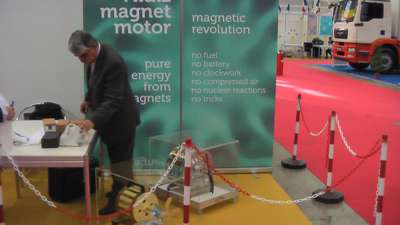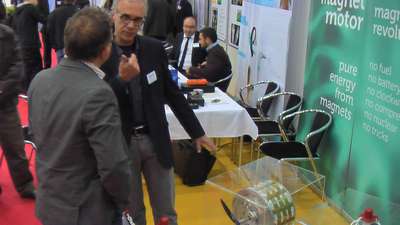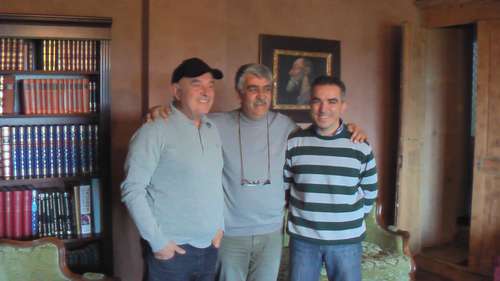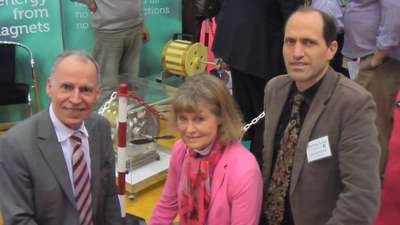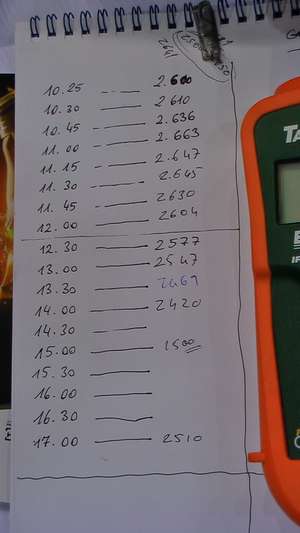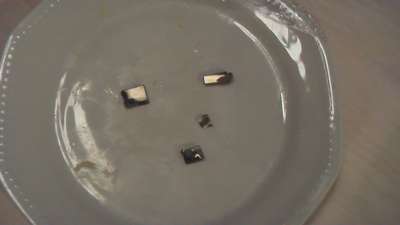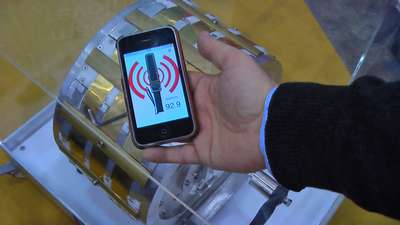35+ Reasons Why I Think Yildiz' Magnet Motor Really Works
by
Sterling D. Allan
Pure Energy Systems News
April 16, 2013
Context
As I fly home from this trip to Geneva where I attended the 41st International Exhibition of Inventions in Geneva, Switzerland, at which Muammer Yildiz demonstrated his magnet motor design (thanks to all you who chipped in to make this trip possible), I thought I would compile a list of a few reasons why I believe that what was demonstrated was indeed an all-magnet motor, and not some kind of trick, hoax, or scam.
(They shouldn't put power plugs on airplanes. It makes it hard for me to sleep knowing I could be working. So much easier to sleep when I only have so much power left in my batteries. So adjusting my biological clock to Mountain Time will have to wait a day.)
Though we were hoping to see the motor run for five days continuously, thereby ruling out any kind of hidden battery or other conventional energy storage mechanism that might have been concealed out of view inside the motor body, it turns out that the motor only ran for 4.5 hours continuously on the first day, before a malfunction occurred.
The malfunction was of four magnets that came loose. The motor slowed, and after a while, a noise could be heard, which is what spurred Yildiz to turn it off.
That night, in the privacy of the motor home he had rented, he opened the motor and extricated the four magnets, two of which had obvious damage to them. In order to clean up the motor of those fragments, he would need 1.5 days and a large area to disassemble the entire motor, clean each magnet (not easy to do) and reassemble the motor.
Instead, he opted to not try and resume continuous operation, but to just give brief demonstrations of the motor running for about a minute, starting it up by releasing the braking mechanism, then stopping it by re-engaging the braking mechanism. He didn't feel the motor was stable enough to run continuously, and he didn't want a cascading, cataclysmic malfunction of this motor that is 15 years old and allegedly contains some 1200 magnets.
There was talk that he might get the smaller motor running, a task he attempted until 4 am the second night, but apparently abandoned.
Prioritized List of Reasons
So, notwithstanding a lackluster demonstration from the vantage point of running it long enough to rule out a hidden battery or other conventional energy storage mechanism, here is a prioritized list of reasons I think that what Yildiz demonstrated is indeed an all-magnet motor, to the level that I would say that this is the "most likely" conclusion:
- No heat, according to measurements made by a laser
thermometer, at the most likely places. While running
continuously, the motor measured the same temperature (22 C) as
ambient temperature. These measurements were taken about every
half hour, and recorded. The only place with a slightly elevated
temperature (23 C) was at the front and back bearings.
- Conventional electric motors produce heat when they run. The more efficient they are, the less heat they produce, but they do produce at least some heat -- more than what was measured.
- Most all other energy-related technologies involve at least SOME HEAT when they operate. This laptop I'm using right now gets plenty warm when I have it turned on.
- HEAT EXPECTED FROM EDDY CURRENTS. There are obviously magnets inside the motor, and according to Duarte, there are moving magnets in the rotor portion of the motor. In conventional settings, when magnets pass by aluminum, an eddy current is created. You've seen illustrations of dropping a magnet down an aluminum tube, and it doesn't drop at free-fall speed, but drops at a constant rate, much slower than the pull of gravity, due to these eddy currents resisting its fall. When such magnets are run at high speed, in vicinity of aluminum, normally, the aluminum will heat up. But in this setting, it doesn't. Something very unusual is happened here. (Theoretically, another inventor, YoungTesla (at YouTube), who came to the expo and hung out at the Yildiz booth, who claims to have built a working magnet motor himself, says that the way Yildiz' motor probably works is that instead of going to heat, the eddy currents are deployed in such a way as to modify the magnetic field of the magnets, assisting the rotational movement.)
- Dr. Jorge Duarte, Assistant Professor from Eindhoven
University in The Netherlands, was fully present at the booth
during the expo, explaining its function, rationale, evidence,
and ramifications. He strikes me as a very honest and sincere
person. I have a hard time believing that he is lying or making
things up. He seemed intent on helping people understand and
appreciate what they were seeing. He has made this stance even
though it jeopardizes is academic prowess among his peers. He is
not just a passive reference, but an active and passionate
proponent of the technology.
- He says, "I am not a 'believer,' I 'know' this works."
- He said he has measured that motor in a laboratory setting running continuously for more than 5 hours, producing a calibrated load of 240 Watts.
- Also at that time, under conditions of confidentiality of the proprietary nature of the design, he said that Yildiz let him see inside the motor and that there were no batteries in there -- only arrangements of materials consistent with an all-magnet motor.
- Duarte has some preliminary scientific models to explain
why this phenomenon works. They seem plausible -- a good
starting point for the scientific discussion that needs to
take place to model this phenomenon.
- Confidence in Muammer Yildiz. I realize that there is
a lot of skepticism regarding Yildiz due to having this for so
long and still not having a scientific validation published
about it. From my vantage point, I can see why that has been the
case, and it has a lot to do with politics of science, not true
science. People have validated it, but have not published those
validations. Despite his challenging personality, I have
confidence that he is not the kind of person to run a scam or a
hoax.
- Yildiz has been pursuing this for 33 years, with apparent working prototypes for at least the most recent 15 years.
- Formerly, he was a Police Chief, and he has a good reputation to uphold, both for himself and for that position.
- Having spent quite a bit of time with him this past
week, I will say that he strikes me as an honest, dedicated,
sincere person. He is not a businessman. Hopefully, others
can take care of that for him. He is, first and foremost, an
inventor.
- Other Personnel References:
- Halil Turkmen and Murat Selcuk Taluy, Yildiz' close associates, have both seen inside the motor and confirm that there are no batteries in there. They also strike me as honest and sincere people. Halil has received no pay for his assistance. He does what he does voluntarily.
- Mr. X (a person I have known for a few years, who has been tracking free energy technologies for years to find working designs ready to assist to bring to market, and who is not easy to convince of something) said of this technology: "Of all the [clean energy] technologies I know of, this one is the most promising." He is going to be having his group perform a scientific validation of a recently completed, alleged 5 kW design, at the end of May. And they are likely to also help bring the other talents to the table: business, legal, finance, licensing, manufacturing, etc. On April 16, he wrote to me: "Yes, we hope to get all unnecessary rumors about the technology out of the way once the testing is completed... And I also think that we can work with the group to find a reasonable licensing approach for everyone..."
- Other pillars in the FE community who came to inspect
the motor at the booth seemed impressed (not just with the
motor but with all the aspects, including those I am
elaborating here). These witnesses included Adolf Schneider
(Switzerland), Ronny Korsberg (Norway), Paolo Mazzorana
(Italy), Dick Korf (Holland), Giorgio Iacuzzo (Nexus,
Switzerland), Roman Susnik (Slovenia), and Eleftherios
Chatzakis (Greece), and many others.
- The start/stop performance of the motor is consistent
with an all-magnet motor.
- When the motor is not spinning, it is under tension,
wanting to spin up, held still by the braking mechanism. As
soon as the brake is released, by Yildiz hitting a mallet
against a screw driver, pushing the brake mechanism out of
position, the motor immediately spins up, in maybe 1/5 of a
second, to its full speed. (Duarte says that the stable
speed is achieved through a feedback mechanism that prevents
the motor spinning to destruction.)
- I saw Duarte demonstrate to someone that when stopped, the blade is under tension of the brake, not easy to turn. (I asked Yildiz if I could try moving it for myself, but he declined. He may have not understood what I was asking. He may have interpreted my hand signals as a request for him to run the motor again.)
- When the motor is spinning, and Yildiz engages the
braking mechanism through an opposite method to releasing
the brake (he hits the start/stop mechanism in the opposite
direction, then fastens a screw to hold it in that
position), the motor spins to a stop in about 4-5 seconds --
much slower than it takes to speed up when the brake is
released. This slow-down time is consistent with A) stopping
a body in motion with kinetic energy to resist, B) the motor
wanting to keep the motion going, working against the
braking mechanism.
- When the motor is not spinning, it is under tension,
wanting to spin up, held still by the braking mechanism. As
soon as the brake is released, by Yildiz hitting a mallet
against a screw driver, pushing the brake mechanism out of
position, the motor immediately spins up, in maybe 1/5 of a
second, to its full speed. (Duarte says that the stable
speed is achieved through a feedback mechanism that prevents
the motor spinning to destruction.)
- RPM Data not consistent with electric motor
- If there were some kind of hidden electric motor, you would expect the speed of rotation at a given setting to be quite constant, not fluctuating up and down as was measured on April 10, 2013 during the first 4.5 hours of continuous running. Also, if that motor was powered by batteries, you would expect a gradual decline in speed as the battery power diminished. Of course, there could be some kind of sophisticated circuitry to mimic what was seen.
- The substantial diminishing in power down to 1500 rpm near the time that the motor was shut off also corresponded to the arrival of a noise that was not there before. That is not consistent with the notion of a hidden motor.
- The increased noise arriving, and the magnet fragments allegedly retrieved from the motor that night are consistent with the story that was told us by Yildiz about why he shut it off.
- Other claims to all-magnet motors. This isn't the only claim to having achieved continuous rotational movement through magnets alone, with no electricity involved in creating that rotation. See Directory:Magnet Motors. There is little doubt in my mind that such a thing is possible, generally speaking.
- The movement of the smaller motor is consistent with an
all-magnet motor, without any kind of electric motor
involved. Though this doesn't necessarily mean that the larger
motor has the same configuration, at least it shows some unusual
aspects that illustrate that Yildiz is indeed working with
all-magnet designs. I know of no electric motors (including
stepper motor) that exhibit all of these attributes.
- At very slow speeds, you can feel and see the cogging of magnets (or magnet sets?) as they pass by one another.
- At slow speeds, it is very difficult to push the blade past a cog point, so much so that you could cut your finger on the blade in the effort if you are not careful.
- After (manually) pushing the blade or spinning the shaft fast enough to make a full rotation, it spins quite easily. That slow-speed resistance is gone.
- As it comes to a stop, it bounces back and forth like
270-degrees a couple of times before the back and forth
motions become smaller, consistent with magnetic action.
- There are a number of evidences that show that there are
many magnets inside, both stationary (stator) and moving
(rotor).
- The cogging effect mentioned above.
- A magnetic sheet that shows emanating magnetic fields, could be seen to move as the small motor turned (manually).
- Two cell phone apps with a magnetometer showed increasingly higher readings as they approached the motors (the smaller motor had a larger external field than the larger motor). As they got too close, the red warning sign would illuminate, warning of a field that could damage the phone. For the small motor, that distance was about 2 feet. For the larger motor, that distance was about 6 inches. (Also, this wasn't repeated to my satisfaction, but apparently while the larger motor was running continuously, at 1/2 meter distance, the magnetic field around it was actually measured to be significantly lower than ambient level. It could have been a glitch in the app. I saw some weird stuff when we were taking measurements a couple of days later.)
- A magnet-attracting coin or magnet held perpendicular to the motor would flit back and forth as the small motor was slowly turned, consistent with a changing magnetic field as the internal magnets passed by.
- I didn't see this illustrated while I was there, but I was told (including by Duarte) that there was a strong magnetic field that could erase magnetic media such as on credit cards, cameras, phones; or effect devices such as pacemakers.
- Coins with magnet-attracting metals in them were strongly attracted to the motor, but not everywhere, just to periodic locations where the stator magnets were located inside.
- I am not an expert in motor sounds, but to me, the starting and running of the motor did not have the sound of an electric motor.
- Spiritual/psychic/intuitive witnesses:
- A couple of my psychic friends said that Yildiz is a good person with a real technology.
- Healer, Daniel Zeuke, who traveled from Lake Constance
(Germany and Switzerland border) to meet Yildiz and see the
motor, said that Yildiz has a clear energy.
Survey
Now, with my explaining my reasons, and having given you a lot of video, live streaming, and explanatory support for what I said above, I'm curious what you, our audience, think at this point about the Yildiz magnet motor.
Here's a link for the following survey:
- - - -
Q. Do you think Yildiz really has achieved an all-magnet motor? See YildizDemo.com
- Certain of it
- Most likely
- Maybe
- Probably not
- Definitely not
- None of the above
- - - -
I personally would not rank it as "certain", but "most likely." Given the number of times I've been initially fooled by what appeared to be legitimate stuff, I can't say "certain" until I see inside for myself, or see it run long enough to rule out any kind of conventional energy storage.
I can't think of anything that would satisfy many of the above observations, but I could be wrong. So even though I'm not "certain", I'm about as close as one could get.
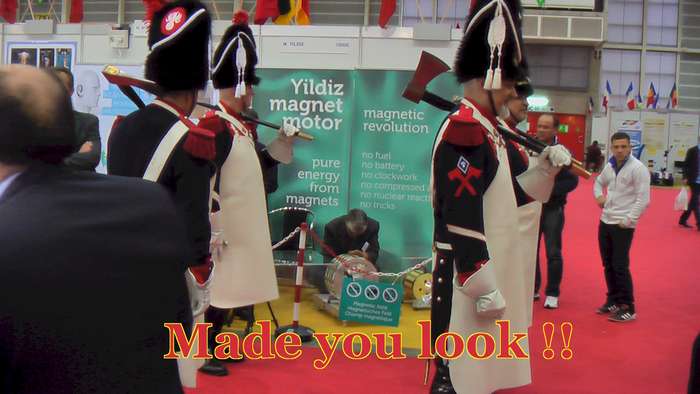
The response of this Swedish delegation security detail is perhaps
somewhat reflective of the varied reactions throughout the expo.
Down-Sides
I'll not elaborate here some of the drawbacks of the technology and the inventor. I mentioned those in my story about my trip to Fabrice Andre's lodge near Mont Blanc, which could be our new #1 technology in the Top 5 Exotic Free Energy Technologies listing.
Donate Button
Again, thanks to all of you who chipped in to help make this trip possible, especially Rene, who let us stay at the B&B villa he rented across the border in France; and Ronny, who rented the motor home we slept in outside the villa, and paid for the gas for our various travels on this adventure; and an anonymous donor who's near $700 contribution pushed us over the minimum needed to make the trip.
Meanwhile, we did have some unexpected expenses with the trip, and I'm still coming up short for meeting the ongoing expenses for running PES and supporting my family of 6 (I do this work like 80 hours/week as my only source of income); so if you could chip in on the "Support Sterling at Yildiz Demo" campaign, I'd surely appreciate it.
Next stop: the Premier of Steven Greer's Sirius documentary film in LA with my wife on April 22, a month early anniversary celebration for us. Thanks to those of you who helped make that possible. I wouldn't be able to do this without my wife's support. There are few ladies who could endure what I've put her through. I'm so fortunate.
While there, I'm going to be stopping in to see the Cogar International technology, with a few scientist friends.
www.pureenergysystems.com
PES Network, Inc.
Copyright © 2003 - 2013
http://peswiki.com/index.php/Article:_35%2B_Reasons_Why_I_Think_Yildiz%27_Magnet_Motor_Really_Works
